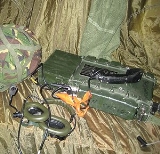
Clansman
Overview
Radio
Radio is the transmission of signals through free space by modulation of electromagnetic waves with frequencies below those of visible light. Electromagnetic radiation travels by means of oscillating electromagnetic fields that pass through the air and the vacuum of space...
system (CNR) used by the British Army
British Army
The British Army is the land warfare branch of Her Majesty's Armed Forces in the United Kingdom. It came into being with the unification of the Kingdom of England and Scotland into the Kingdom of Great Britain in 1707. The new British Army incorporated Regiments that had already existed in England...
from 1976 to 2010.
Clansman was developed by the Signals Research and Development Establishment
Signals Research and Development Establishment
The Signals Research and Development Establishment was a British government military research establishment, based in Christchurch, Dorset from 1948 until it merged with the Royal Radar Establishment in Malvern, Worcestershire to form the Royal Signals and Radar Establishment in 1980...
(SRDE) in the 1960s, to satisfy a General Staff Requirement (GSR) laid down in 1965. Built by Racal
Racal
Racal Electronics plc was once the third-largest British electronics firm. Listed on the London Stock Exchange and once a constituent of the FTSE 100 Index, Racal was a diversified company, offering products including: as voice and data recorders; point of sale terminals; laboratory instruments;...
, MEL and Plessey
Plessey
The Plessey Company plc was a British-based international electronics, defence and telecommunications company. It originated in 1917, growing and diversifying into electronics. It expanded after the second world war by acquisition of companies and formed overseas companies...
, Clansman represented a considerable advance over existing radios being offered to the Armed Forces at the time. It replaced the aging Larkspur radio system
Larkspur radio system
Larkspur was the name of a tactical radio system used by the British Army. Its development started in the late 1940s with the first equipments being issued in the mid-1950s. It remained in service until replaced by Clansman in the late-1970s although some elements of Larkspur were still in service...
, and proved to be more flexible, reliable and far lighter.

